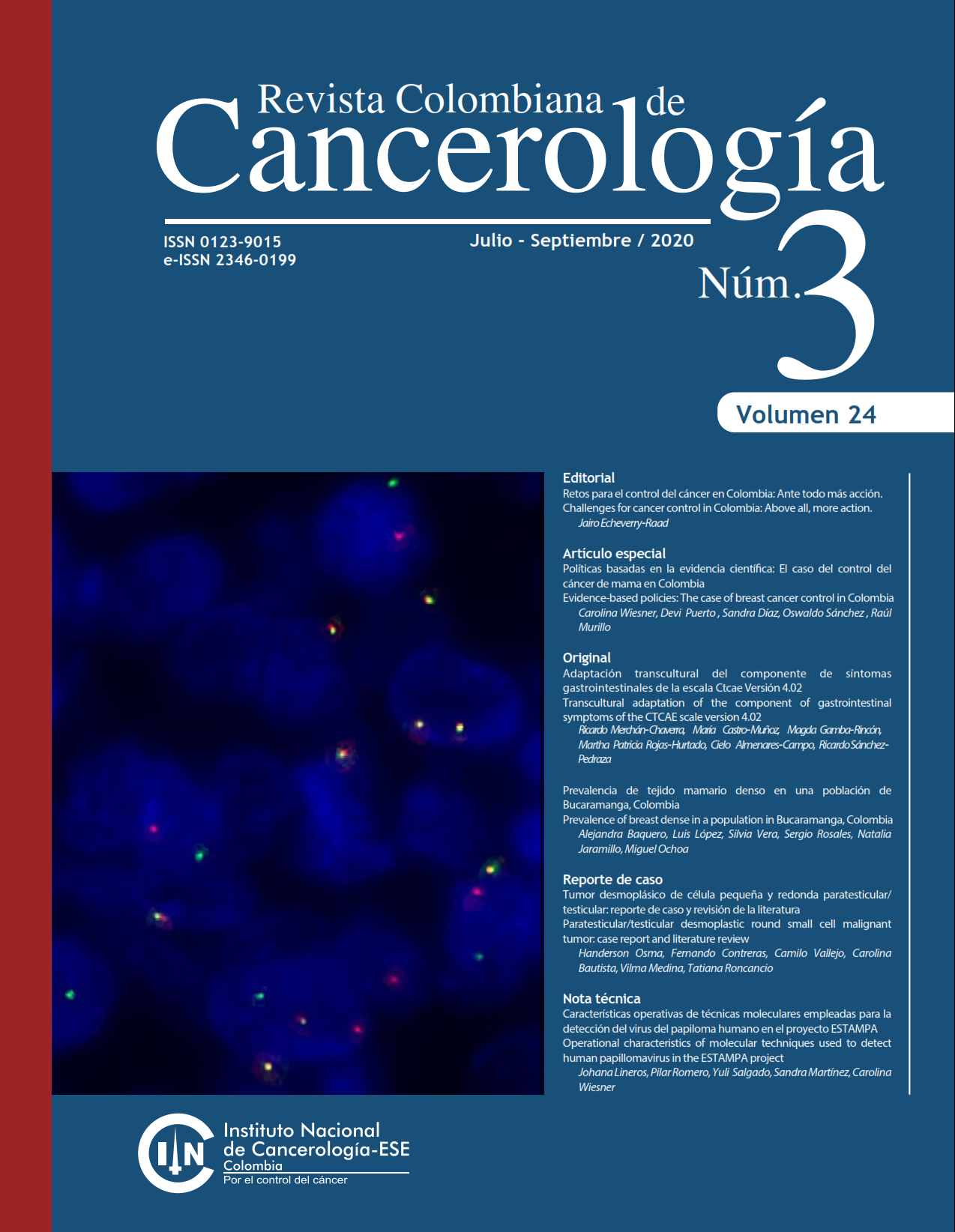Operational characteristics of molecular techniques used to detect human papillomavirus in the ESTAMPA project
DOI:
https://doi.org/10.35509/01239015.106Keywords:
Human Papillomavirus, Cervical Cancer, Hybrid Capture 2, molecular testsAbstract
The development and innovation of new technologies has improved the detection of high-risk human papillomavirus infection. Hybrid capture II is an assay that is based on hybridization and chemiluminescence. Cobas HPV Test is a qualitative PCR and Aptima HPV Assay allows to detect the expression of messenger RNA of the high-risk HPV E6 / E7 oncoproteins. These techniques have advantages, in comparison, with conventional cytology that is routinely used for the detection of cervical cancer. In the ESTAMPA study, 13,691 prosecutions were carried out that allowed to identify that for the planning of research projects or for the implementation of HPV screening tests, it is necessary to analyze the advantages and disadvantages of market tests.
References
Rincón, L., & García, D. (2012). Boletín Hechos y Acciones VPH. MinSalud. Instituto Nacional de Cancerología, Bogotá D. C.
Contreras, R. (2015). Papanicolaou y citología líquida en diagnóstico de cáncer de cérvix. Comunidad y Salud vol.13 no.1 Maracay- Venezuela. , 13(1).
OPS. (2012). Incorporación de la prueba del virus del papiloma humano en programas de prevención de cáncer cervicouterino sección 2: resumen de las pruebas de VPH. (O. P. Salud, Ed.) Recuperado el 24 de Marzo de 2018, de https://www.paho.org/hq/index.php?option=com_docman&task=doc_view&Itemid=270&gid=36609&lang=es
Ngou, J., Gilham, C., Omar, T., Goumbri-Lompo, Doutre, S., Michelow, P., DelanyMoretlwe, S. (2015). Comparison of Analytical and Clinical Performances of the Digene HC2 HPV DNA Assay and the INNO-LiPA HPV Genotyping Assay for Detecting High-Risk HPV Infection and Cervical Neoplasia Among HIV-Positive
African Women. Journal of Acquired Immune Deficiency Syndromes, 68(2), 162–168.
Sasagawa , T., Toshiyuki, M., Osaka, Y., Jinichi , S., Shibata , T., & Fujita , S. (5 de Enero de 2018). Comparison of the digene hybrid capture 2 and Roche cobas 4800 HPV tests for detection of CIN2+ in a referral population in Japan. Journal of medical Virology.
IARC. (2014). Estudio multicéntrico de tamizaje y triage de cáncer de cuello uterino con pruebas del Virus de Papiloma Humano (ESTAMPA). Versión de protocolo 3.0, Fecha: 23/05/2014.
Qiagen. (2010). Inserto Prueba digne® HC2 HPV DNA Instrucciones de uso. Estados Unidos 24 de Marzo de 2018, de https://www.qiagen.com/uz/resources/download.aspx?id=6396d4fd-c301-4fea-b5b1-01924735d980& lang=esES
Román, G. (2008). Captura Híbrida de ADN del Virus de Papiloma Humano en la Detección de Tipos de Alto Riesgo para el Cáncer de Cérvix Uterino (Revisión Bibliográfica) lxv (585) 285-290;2008. Revista Médica de Costa Rica y Centroamérica, 285-290
Apas , A., Perrotta , M., & Maciel , A. (junio de 2016). Aplicaciones clínicas, toma de la muestra y lectura de los test de HPV. Sociedad Argentina de patología del tracto genital inferior y colposcopía.
Roche. (2012). cobas® 4800 HPV Test. Obtenido de Roche Diagnostics. Recuperado el 24 de Marzo de 2018, de https://www.accessdata.fda.gov/cdrh_docs/pdf10/p100020s017c.pdf
Hologic, Inc. (2017). Inserto. Obtenido de Aptima HPV Assay: https://www.hologic.com/sites/default/files/package-insert/AW-14517301_003_01.pdf
How to Cite
Downloads
Downloads
Published
Issue
Section
License
Copyright (c) 2020 Revista Colombiana de Cancerología

This work is licensed under a Creative Commons Attribution-NonCommercial-NoDerivatives 4.0 International License.
Todos los derechos reservados.





